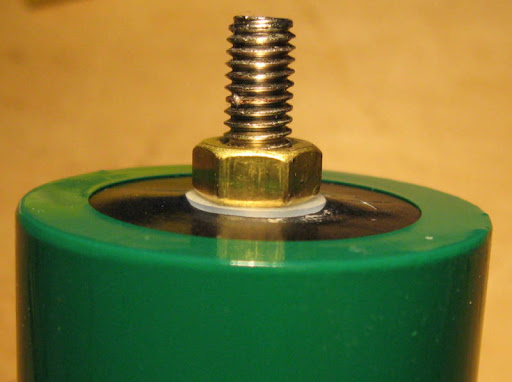 Here's a 'family portrait' of sorts. The pair of yellow cells are A123Systems 18650 cells. These were removed from a Black and Decker VPX pack. The larger white cell is a 26650 cell from A123Systems. It was removed from a 36volt DeWalt DC9360 battery pack. The green cell is our text subject, a 40138 LiFePO4 cell.
Here's a 'family portrait' of sorts. The pair of yellow cells are A123Systems 18650 cells. These were removed from a Black and Decker VPX pack. The larger white cell is a 26650 cell from A123Systems. It was removed from a 36volt DeWalt DC9360 battery pack. The green cell is our text subject, a 40138 LiFePO4 cell.The numbers - 18650, 26650 and 40138 - give cell dimensions in milimetres. The first pair of numbers - 18, 26, and 40 are the cell diameter. The 650 and 138 are cell length without terminals...almost. The smaller cells swap the zero around. The pair of cells from A123Systems are about 65mm long - not 650.
The smaller cells have connections spot welded on. The larger cell is fitted with 6mm bolts. This makes it easy to wire a pack, and change pack configuration later.

Here's a close-up of a cell terminal. See the nylon washer under the nut? That's part of the cell's sealing system. The nuts on the terminal studs must stay in place. Loosen the nut and the cell will leak.
The cell is covered with a layer of shrink wrap insulation. There's a barcode label on the aluminum cell casing in addition to the one on the outside.
 Here's a terminal mounting example. The connection strap is against the nut installed on the cell. There's an optional flat washer against the strap, then a mandatory lock washer, and nut.
Here's a terminal mounting example. The connection strap is against the nut installed on the cell. There's an optional flat washer against the strap, then a mandatory lock washer, and nut.
Here's another wiring example. The 1/4 inch crimp-on ring terminals are connected to 10AWG wires. There's enough room for a pair of terminals as long as they're 'back to back'.
It's very important to secure each connection. Use lock washers, spring washers, locktite, or something similar on all cell connections. Electrical resistance increases when a connection becomes loose. Just like an electric stove burner, current flow and resistance equals heat. At best, performance will decrease as nuts loosen. At worst, the connection can heat enough at higher electrical flow to start a fire.
Inspect cell connections as part of your preventive maintenance schedule. You can use fingernail polish on the end of the nut to see if the connection has loosened.
It's best to use a torque wrench when assembling cells into a pack. Maximum torque is 6.9 lb-in or .78 nm.




